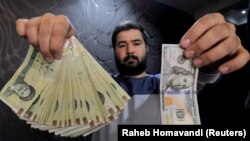Eighty-four years after changing the Iranian national currency unit from the Gheran (crown) to the rial, the cabinet of President Hassan Rouhani finally proposed a bill to switch it to the toman.
However, the bill, ratified on July 23, needs parliament’s approval, as well as the Guardian Council’s endorsement to become law.
The word toman is a Mongolian term that literally means 10,000.
The secretary of the cabinet, Mohsen Haji Mirzaei, said the government’s economic commission had analyzed the subject for the past six months, the official Islamic Republic News Agency (IRNA) reported.
Haji Mirzaei added the move aims to facilitate financial transactions by the public.
Furthermore, he explained that one toman would be worth 10 rials, and switching to the toman means that a zero would be removed from price figures.
In the past decades the word rial was rarely used by the ordinary people. In their daily conversations and in the markets, on most price tags, traders and consumers always used toman. But official government documents and budget figures spoke of rial.
Earlier, the governor of the Central Bank of Iran (CBI), Valiollah Seif, who reportedly is the mastermind behind the switch, was quoted as saying that the rial had been virtually removed from transactions in Iran because of rising inflation over the past several decades, Iran’s Press TV reported.
Before the Iranian revolution, one U.S. dollar bought 6.7 tomans and today it is about 3,000. In the last decade or so, the value of Iran’s currency dropped so much that even one toman actually was used to mean 1,000 tomans. If someone said some item is 10 tomans, he actually meant 10,000 or $3.3.
The move harks back to the days of Mohammad Shah Qajar (1834-1848), when the toman, with its subunit qiran, was officially endorsed as Iran’s national currency.
Seif has mentioned removing a zero from price figures in the country, but there are experts who have begged to differ with the CBI governor, saying more zeros should be removed.
“The Economy Commission has proposed that up to four zeros must be dropped to lighten our national currency; though, at the end of the day, dropping one or more zeros will have no impact on people’s purchasing power,” said Mohammad Reza Pourebrahimi, the head of the commission.
“Dropping more zeros,” Pourebrahimi argued, “is much simpler and creates a psychologically better atmosphere [for transactions].”
Earlier, in an analysis for Radio Farda, Paris-based economics professor Fereydoun Khavand had emphasized that “dropping one or more zeros to bestow credibility on a national currency is, more or less, a routine development in modern times.”
Since World War II, Khavand argued, “More than 70 countries, including Germany, France, Brazil, Argentina, Turkey, and Afghanistan have removed zeros from their coins and bank notes.”
Nevertheless, Khavand immediately emphasized, “Eliminating zeros is only beneficial when the factors feeding national economic degeneration are also eliminated.”
Dropping zeros and changing the national currency unit is a lengthy and costly procedure, which is why the CBI governor has insisted it will be done one step at a time and “will be possible only after two years.”
Moreover, the new plan is highly expected to face widespread protests over accepting a Mongolian, not Persian, term for the national currency unit.
Iran is among the first nations in the history of mankind to introduce a standard monetary unit for financial transactions.
The Persian daric was a gold coin that represented the monetary standard of the Achaemenid Empire. Cyrus the Great (550-530 BC) introduced coins to the Persian Empire after 546 BC.
Achaemenid coins were highly trusted throughout the vast empire, as always reliable in their purity of gold.





